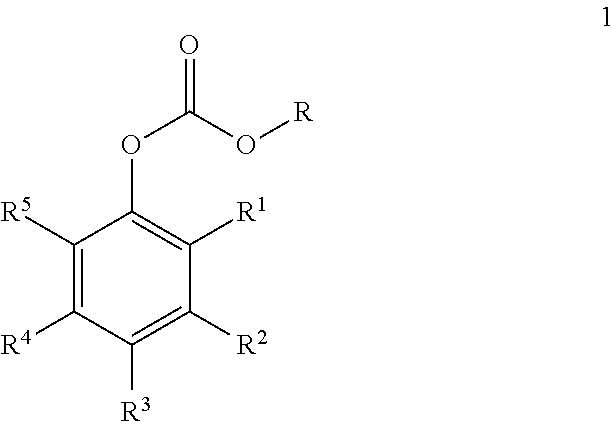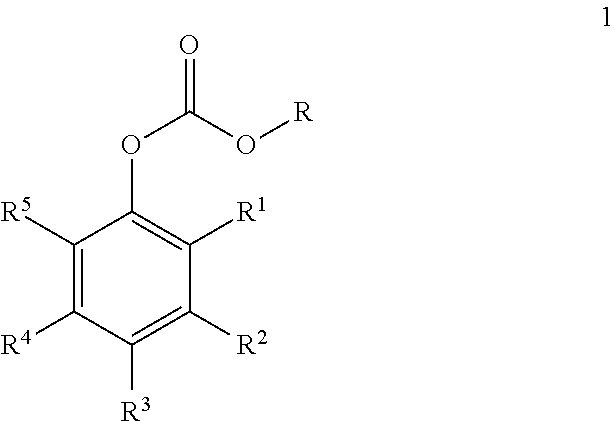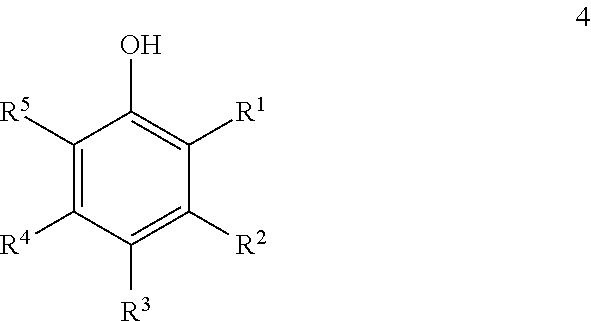Carbonate derivatives as skin care
a technology of carbonate derivatives and anti-aging ingredients, which is applied in the field of alkyl carbonates of anti-aging ingredients, can solve the problems of unstable in a cosmetic formulation, unsuitable physical properties of materials, and inability to improve the stability of catechol functionality
- Summary
- Abstract
- Description
- Claims
- Application Information
AI Technical Summary
Problems solved by technology
Method used
Image
Examples
example 1
Preparation of Resveratrol tris(methyl carbonate) (Formula 2, R=Me)
[0026]Resveratrol (15 g; 65.7 mmol) was combined with dichloromethane (80 mL), and pyridine (18.8 g; 236 mmol; 3.6 equiv) was added dropwise. Methyl chloroformate (26.2 g; 278 mmol; 4.2 equiv) were added, and the reaction mixture was heated to reflux for 1 h, at which point HPLC analysis indicated five major peaks. Pyridine (6.3 g; 79.6 mmol; 1.2 equiv) and methyl chloroformate (8.8 g; 93.1 mmol; 1.4 equiv) were added and refluxed for 1 h, and this was repeated twice more until a single peak was observed by HPLC analysis. The mixture was diluted with ethyl acetate (250 mL) and washed with 3 M HCl (3×250 mL) and 5% sodium bicarbonate (3×250 mL). The organic solution was dried with sodium sulfate and concentrated to afford 26.6 g of crude hydroxytyrosol tris(methyl carbonate) (Formula 2, R=Me). The crude product was crystallized from 160 g of isopropyl alcohol to afford 21.4 g of resveratrol tris(methyl carbonate) (81%...
example 2
Preparation of Resveratrol tris(butyl carbonate) (2, R=n-Bu)
[0029]Resveratrol (10.0 g; 43.8 mmol) was dissolved in 50 mL (618 mmol; 14.1 equiv) of pyridine. The mixture was diluted with toluene (75 mL) and treated with n-butyl chloroformate (19.15 g; 140 mmol; 3.2 equiv) dissolved in 25 mL of toluene. An exotherm was noted during the addition, and cooling was applied (maximum temperature was 37° C.). The resulting white stirrable slurry was stirred overnight at ambient temperature, at which point HPLC analysis indicated one major product but several minor peaks (assumed to be mono- and di-carbonates). An additional 20% of butyl chloroformate (3.8 g) was added and the mixture was stirred overnight, at which point HPLC analysis indicated >94% of a single peak. The mixture was partitioned between 150 mL of ethyl acetate and 100 mL of water, and the water layer was decanted. The organic layer was washed with 3 M HCl (200 mL) and 5% sodium bicarbonate (100 mL), dried (MgSO4), then concen...
example 3
Enzymatic hydrolysis of Resveratrol tris(methyl carbonate)
[0035]Resveratrol tris(methyl carbonate) (100 mg; 0.249 mmol) was dissolved in 2 mL of toluene. 2 mL of pH 7 buffer was added followed by 100 mg of Novozym 435 (immobilized Candida Antarctica lipase B). The mixture was stirred vigorously at ambient temperature for 22 h, at which point the HPLC analysis (equal volumes of both layers) indicated 23.75% resveratrol, 52.9% resveratrol mono(methyl carbonate), 15.8% resveratrol bis(methyl carbonate) and 7.0% resveratrol tris(methyl carbonate). After 3 days at ambient temperature HPLC analysis indicated 63.8% resveratrol, 35.1% resveratrol mono(methyl carbonate), 0.6% resveratrol bis(methyl carbonate), and no detectable resveratrol tris(butyl carbonate). A similar reaction run in the absence of enzyme showed no detectable hydrolysis after 3 days.
PUM
| Property | Measurement | Unit |
|---|---|---|
| temperature | aaaaa | aaaaa |
| temperature | aaaaa | aaaaa |
| temperature | aaaaa | aaaaa |
Abstract
Description
Claims
Application Information
 Login to View More
Login to View More - R&D
- Intellectual Property
- Life Sciences
- Materials
- Tech Scout
- Unparalleled Data Quality
- Higher Quality Content
- 60% Fewer Hallucinations
Browse by: Latest US Patents, China's latest patents, Technical Efficacy Thesaurus, Application Domain, Technology Topic, Popular Technical Reports.
© 2025 PatSnap. All rights reserved.Legal|Privacy policy|Modern Slavery Act Transparency Statement|Sitemap|About US| Contact US: help@patsnap.com



